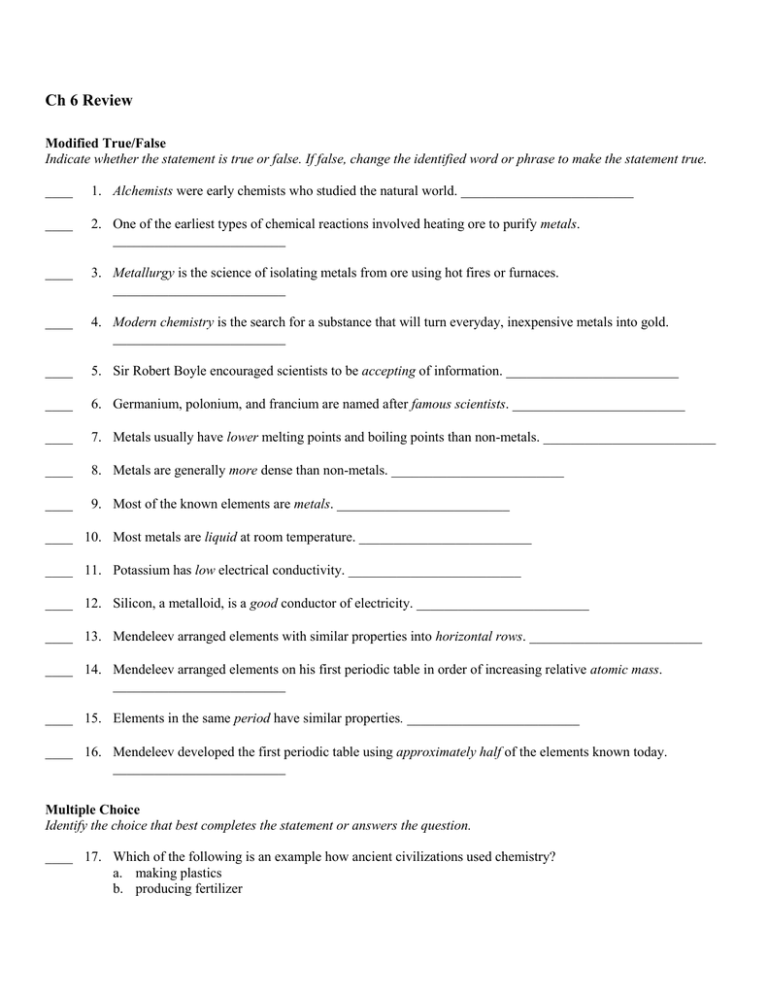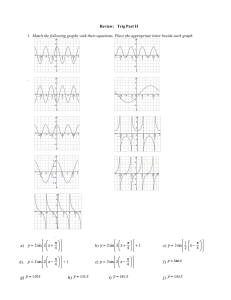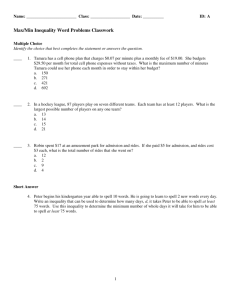Chapter 6 Review
advertisement

Ch 6 Review Modified True/False Indicate whether the statement is true or false. If false, change the identified word or phrase to make the statement true. ____ 1. Alchemists were early chemists who studied the natural world. _________________________ ____ 2. One of the earliest types of chemical reactions involved heating ore to purify metals. _________________________ ____ 3. Metallurgy is the science of isolating metals from ore using hot fires or furnaces. _________________________ ____ 4. Modern chemistry is the search for a substance that will turn everyday, inexpensive metals into gold. _________________________ ____ 5. Sir Robert Boyle encouraged scientists to be accepting of information. _________________________ ____ 6. Germanium, polonium, and francium are named after famous scientists. _________________________ ____ 7. Metals usually have lower melting points and boiling points than non-metals. _________________________ ____ 8. Metals are generally more dense than non-metals. _________________________ ____ 9. Most of the known elements are metals. _________________________ ____ 10. Most metals are liquid at room temperature. _________________________ ____ 11. Potassium has low electrical conductivity. _________________________ ____ 12. Silicon, a metalloid, is a good conductor of electricity. _________________________ ____ 13. Mendeleev arranged elements with similar properties into horizontal rows. _________________________ ____ 14. Mendeleev arranged elements on his first periodic table in order of increasing relative atomic mass. _________________________ ____ 15. Elements in the same period have similar properties. _________________________ ____ 16. Mendeleev developed the first periodic table using approximately half of the elements known today. _________________________ Multiple Choice Identify the choice that best completes the statement or answers the question. ____ 17. Which of the following is an example how ancient civilizations used chemistry? a. making plastics b. producing fertilizer c. producing margarine d. colouring fabric using natural dyes ____ 18. Which of the following activities are used by modern chemists, but were not used by alchemists? I They share information. II They perform experiments. III They are skeptical of information. a. b. c. d. I and II only I and III only II and III only I, II, and III ____ 19. What was believed to turn common metals into gold, cure disease, and prolong life? a. metallurgy b. fermentation c. philosopher’s stone d. earth, air, fire, and water ____ 20. Which of the following was a major challenge or were major challenges to early chemists? a. communicating their findings with others b. the absence of a common naming and symbol system c. the large number of elements discovered in the 1700s and 1800s d. all of the above ____ 21. Which of the following was a key occurrence in the development of modern chemistry? a. ideas were tested through experimentation b. scientific societies did not share their knowledge c. many new elements were broken down into compounds d. observations were interpreted according to beliefs held at the time ____ 22. Which of the following is an observation? a. a candle burns b. wax is fuel for the burning candle c. a hand held close to the burning candle feels warmth d. all of the above ____ 23. Which of the following is an inference? a. There is a powder on the table. b. The powder is yellow. c. The powder is sulphur. d. all of the above ____ 24. Which of the following describe a scientific theory? I It is subject to change. II It can be applied in a variety of circumstances. III It is an established and experimentally verified explanation of observations. a. b. c. d. I and II only I and III only II and III only I, II, and III ____ 25. In which of the following ways did elements get their names? a. from special properties b. from the original Latin name c. to honour scientists, cities, and countries d. all of the above ____ 26. Which of the following contains only one element? a. Co b. CO c. NaCl d. H2O ____ 27. Which two words apply to oxygen, O2, at room temperature? a. gas, element b. gas, compound c. liquid, compound d. liquid, non-metal ____ 28. Which of the following explains why the symbol for copper is Cu? a. C is used by carbon b. Co is used by cobalt c. Cr is used by chromium d. Cu is taken from the Latin cuprum ____ 29. A scientist wants to name a newly discovered element after his Grade 9 science teacher, Miss Harvey. Which symbol do you suggest he use? a. S b. Si c. Sh d. Sm ____ 30. Which of the following explains why copper is used for household wiring? I It is ductile. II It is orange in colour. III It is a good conductor of heat and electricity. a. b. c. d. I and II only I and III only II and III only I, II, and III ____ 31. Which of the following elements is a metalloid? a. silicon b. sulphur c. potassium d. phosphorus ____ 32. What group contains elements used in the semiconductors of computer? a. metals b. metalloids c. non-metals d. magnetic metals ____ 33. Where are metals found on the periodic table of the elements? a. towards the left b. towards the right c. in the first column d. along the staircase ____ 34. What metal is a liquid at room temperature? a. iron b. gold c. silver d. mercury ____ 35. What are elements that have a dull appearance and are poor conductors of heat and electricity? a. metals b. non-metals c. metalloids d. all of the above ____ 36. A newly discovered element has the following properties: - it is brittle - it has a shiny lustre - it is a non-conductor of heat and electricity. In which of the following groups does it best fit? a. metal b. metalloid c. noble gas d. non-metal ____ 37. Copper, silver, and gold are the ‘coinage metals’ because in the past coins were made from these metals. Which of the following explains why they were useful for coins? a. They are shiny. b. They are dense. c. They conduct heat well. d. They react slowly with air and water. ____ 38. Which metals are magnetic? a. all metals b. iron, cobalt, nickel c. metals that react with acid-producing hydrogen gas d. metals that are good conductors of heat and electricity ____ 39. What property did Mendeleev use to order the elements? a. density b. melting point c. comparative mass d. reactivity with acid ____ 40. Which of the following are noble gases? a. F, Cl b. Ar, Kr c. O2, N2 d. CO2, O2 ____ 41. Which pairs of elements would have similar properties? a. silicon and arsenic b. fluorine and bromine c. hydrogen and oxygen d. sodium and magnesium ____ 42. Which pairs of elements are not arranged in order of increasing atomic mass on the modern periodic table? a. iron and cobalt b. neon and sodium c. lead and bismuth d. tellurium and iodine ____ 43. Which of the following conclusions applies to Mendeleev’s periodic table? a. It identified many new elements. b. It was based on Mendeleev’s own experimental work. c. It gave a new understanding of how to group elements. d. all of the above ____ 44. Which of the following did Mendeleev need to create his periodic table? I relative masses of the elements II physical properties of the elements III chemical properties of the elements a. b. c. d. I and II only I and III only II and III only I, II and III Completion Complete each statement. 45. The first elements to be discovered were____________________. 46. ____________________ is the symbol for the element iodine. 47. U is the symbol for the element ____________________. 48. The symbol for the element ____________________ is Fe. 49. The element nitrogen has the symbol ____________________. 50. ____________________ was named for the special property it has - it glows in the dark. 51. An alloy of mercury and other metals is called a(n) ____________________. 52. Many non-metals are in the ____________________ state at room temperature. 53. Gold, compared to all other metals, is the best ____________________ of electricity. 54. ____________________ are found along the staircase of the periodic table of the elements. 55. Iron, cobalt, and nickel share a property that other metals do not have. They are ____________________. 56. Mendeleev grouped elements with similar properties into ____________________. 57. A horizontal row on the periodic table is called a(n) ____________________. 58. A vertical column of elements on the periodic table with similar properties is called a(n) ____________________. 59. Moving from top to bottom down any group, atomic mass ____________________. 60. Three examples of the noble gases are ____________________, ____________________, and ____________________. 61. ____________________ and ____________________ sit side by side on the periodic table, but are unusual because their atomic masses do not increase from left to right. 62. Most metals do not react violently when they get wet. Group ____________________ metals, however, do. 63. Sodium reacts with water to produce ____________________, a flammable gas. 64. The last family of elements to be discovered were the ______________________________. Ch 6 Review Answer Section MODIFIED TRUE/FALSE 1. ANS: OBJ: 2. ANS: OBJ: 3. ANS: OBJ: 4. ANS: T 6.1 T 6.1 T 6.1 F, Alchemy PTS: 1 LOC: Unit B - PLC1 PTS: 1 LOC: Unit B - PLC1 PTS: 1 LOC: Unit B - PLC1 REF: TOP: REF: TOP: REF: TOP: K Unit B - Ch. 06 KI1 K Unit B - Ch. 06 KI1 K Unit B - Ch. 06 KI1 PTS: 1 REF: K TOP: Unit B - Ch. 06 KI1 5. ANS: F skeptical doubting OBJ: 6.1 LOC: Unit B - PLC1 PTS: 1 REF: K TOP: Unit B - Ch. 06 KI2 6. ANS: F, countries OBJ: 6.1 LOC: Unit B - PLC1 PTS: 1 REF: K TOP: Unit B - Ch. 06 KI2 7. ANS: F, higher OBJ: 6.2 LOC: Unit B - PLC3 1 REF: K OBJ: 6.2 Unit B - Ch. 06 KI3 T PTS: 1 6.2 LOC: Unit B - PLC2 T PTS: 1 6.2 LOC: Unit B - PLC2 F, solid LOC: Unit B - PLC2 PTS: TOP: 8. ANS: OBJ: 9. ANS: OBJ: 10. ANS: REF: TOP: REF: TOP: K Unit B - Ch. 06 KI3 K Unit B - Ch. 06 KI3 PTS: 1 REF: K TOP: Unit B - Ch. 06 KI3 11. ANS: F, high OBJ: 6.2 LOC: Unit B - PLC2 PTS: 1 REF: K TOP: Unit B - Ch. 06 KI3 12. ANS: F, poor OBJ: 6.2 LOC: Unit B - PLC2 PTS: 1 REF: K TOP: Unit B - Ch. 06 KI3 13. ANS: F, vertical columns OBJ: 6.2 LOC: Unit B - PLC2 OBJ: 6.3 LOC: Unit B - PLC2 PTS: 1 REF: K TOP: Unit B - Ch. 06 KI4 14. ANS: T PTS: 1 OBJ: 6.3 LOC: Unit B - PLC2 15. ANS: F column group PTS: TOP: 16. ANS: OBJ: 1 REF: K OBJ: 6.3 Unit B - Ch. 06 KI4 T PTS: 1 6.3 LOC: Unit B - PLC2 REF: K TOP: Unit B - Ch. 06 KI4 LOC: Unit B - PLC2 REF: K TOP: Unit B - Ch. 06 KI4 MULTIPLE CHOICE 17. ANS: LOC: 18. ANS: LOC: 19. ANS: LOC: 20. ANS: LOC: 21. ANS: LOC: 22. ANS: LOC: 23. ANS: LOC: 24. ANS: LOC: 25. ANS: LOC: 26. ANS: LOC: 27. ANS: LOC: 28. ANS: LOC: 29. ANS: LOC: 30. ANS: LOC: 31. ANS: LOC: 32. ANS: LOC: 33. ANS: LOC: D PTS: Unit B - PLC1 B PTS: Unit B - PLC1 C PTS: Unit B - PLC1 D PTS: Unit B - PLC1 A PTS: Unit B - PLC1 C PTS: Unit B - PLC1 C PTS: Unit B - PLC1 D PTS: Unit B - PLC1 D PTS: Unit B - PLC1 A PTS: Unit B - PLC2 A PTS: Unit B - PLC2 D PTS: Unit B - PLC2 C PTS: Unit B - PLC2 B PTS: Unit B - PLC2 A PTS: Unit B - PLC2 B PTS: Unit B - PLC2 A PTS: Unit B - PLC2 1 1 1 1 1 1 1 1 1 1 1 1 1 1 1 1 1 REF: TOP: REF: TOP: REF: TOP: REF: TOP: REF: TOP: REF: TOP: REF: TOP: REF: TOP: REF: TOP: REF: TOP: REF: TOP: REF: TOP: REF: TOP: REF: TOP: REF: TOP: REF: TOP: REF: TOP: U/A OBJ: Unit B - Ch. 06 KI1 U/A OBJ: Unit B - Ch. 06 KI1 K OBJ: Unit B - Ch. 06 KI1 U/A OBJ: Unit B - Ch. 06 KI2 U/A OBJ: Unit B - Ch. 06 KI2 U/A OBJ: Unit B - Ch. 06 KI2 U/A OBJ: Unit B - Ch. 06 KI2 U/A OBJ: Unit B - Ch. 06 KI2 K OBJ: Unit B - Ch. 06 KI2 K OBJ: Unit B - Ch. 06 KI3 K OBJ: Unit B - Ch. 06 KI3 U/A OBJ: Unit B - Ch. 06 KI2 U/A OBJ: Unit B - Ch. 06 KI3 U/A OBJ: Unit B - Ch. 06 KI3 U/A OBJ: Unit B - Ch. 06 KI3 K OBJ: Unit B - Ch. 06 KI3 K OBJ: Unit B - Ch. 06 KI3 6.1 6.1 6.1 6.1 6.1 6.1 6.1 6.1 6.2 6.2 6.2 6.2 6.2 6.2 6.2 6.2 6.2 34. ANS: LOC: 35. ANS: LOC: 36. ANS: LOC: 37. ANS: LOC: 38. ANS: LOC: 39. ANS: LOC: 40. ANS: LOC: 41. ANS: LOC: 42. ANS: LOC: 43. ANS: LOC: 44. ANS: LOC: D PTS: Unit B - PLC2 B PTS: Unit B - PLC2 B PTS: Unit B - PLC2 D PTS: Unit B - PLC2 B PTS: Unit B - PLC2 C PTS: Unit B - PLC2 B PTS: Unit B - PLC2 B PTS: Unit B - PLC2 D PTS: Unit B - PLC2 C PTS: Unit B - PLC2 D PTS: Unit B - PLC2 1 1 1 1 1 1 1 1 1 1 1 REF: TOP: REF: TOP: REF: TOP: REF: TOP: REF: TOP: REF: TOP: REF: TOP: REF: TOP: REF: TOP: REF: TOP: REF: TOP: K OBJ: Unit B - Ch. 06 KI3 K OBJ: Unit B - Ch. 06 KI3 U/A OBJ: Unit B - Ch. 06 KI3 U/A OBJ: Unit B - Ch. 06 KI3 K OBJ: Unit B - Ch. 06 KI3 K OBJ: Unit B - Ch. 06 KI4 U/A OBJ: Unit B - Ch. 06 KI4 U/A OBJ: Unit B - Ch. 06 KI4 U/A OBJ: Unit B - Ch. 06 KI4 U/A OBJ: Unit B - Ch. 06 KI4 K OBJ: Unit B - Ch. 06 KI4 6.2 6.2 6.2 6.2 6.2 6.3 6.3 6.3 6.3 6.3 6.3 COMPLETION 45. ANS: metals PTS: 1 REF: K TOP: Unit B - Ch. 06 KI1 46. ANS: I OBJ: 6.1 LOC: Unit B - PLC1 PTS: 1 REF: U/A TOP: Unit B - Ch. 06 KI2 47. ANS: uranium OBJ: 6.2 LOC: Unit B - PLC3 PTS: 1 REF: U/A TOP: Unit B - Ch. 06 KI2 48. ANS: iron OBJ: 6.2 LOC: Unit B - PLC3 PTS: 1 REF: U/A TOP: Unit B - Ch. 06 KI2 49. ANS: N OBJ: 6.2 LOC: Unit B - PLC3 PTS: 1 REF: U/A TOP: Unit B - Ch. 06 KI2 50. ANS: Phosphorus OBJ: 6.2 LOC: Unit B - PLC3 OBJ: 6.1 LOC: Unit B - PLC1 PTS: 1 REF: K TOP: Unit B - Ch. 06 KI1 51. ANS: amalgam PTS: 1 REF: K TOP: Unit B - Ch. 06 KI1 52. ANS: gas gaseous OBJ: 6.1 LOC: Unit B - PLC1 PTS: 1 REF: K TOP: Unit B - Ch. 06 KI3 53. ANS: conductor OBJ: 6.2 LOC: Unit B - PLC2 PTS: 1 REF: K TOP: Unit B - Ch. 06 KI3 54. ANS: Metalloids OBJ: 6.2 LOC: Unit B - PLC2 PTS: 1 REF: K TOP: Unit B - Ch. 06 KI3 55. ANS: magnetic OBJ: 6.2 LOC: Unit B - PLC2 PTS: 1 REF: K TOP: Unit B - Ch. 06 KI3 56. ANS: columns OBJ: 6.2 LOC: Unit B - PLC2 PTS: 1 REF: K TOP: Unit B - Ch. 06 KI4 57. ANS: period OBJ: 6.3 LOC: Unit B - PLC2 PTS: 1 REF: K TOP: Unit B - Ch. 06 KI4 58. ANS: group family OBJ: 6.3 LOC: Unit B - PLC2 PTS: 1 REF: K TOP: Unit B - Ch. 06 KI4 59. ANS: increases OBJ: 6.3 LOC: Unit B - PLC2 PTS: 1 REF: U/A OBJ: 6.3 TOP: Unit B - Ch. 06 KI4 60. ANS: helium, neon, argon, krypton, xenon, radon LOC: Unit B - PLC2 PTS: 1 REF: K TOP: Unit B - Ch. 06 KI4 61. ANS: argon, tellurium potassium, iodine OBJ: 6.3 LOC: Unit B - PLC2 PTS: 1 REF: K TOP: Unit B - Ch. 06 KI4 OBJ: 6.3 LOC: Unit B - PLC2 62. ANS: I PTS: 1 REF: K TOP: Unit B - Ch. 06 KI4 63. ANS: hydrogen OBJ: 6.3 LOC: Unit B - PLC2 PTS: 1 REF: K TOP: Unit B - Ch. 06 KI4 64. ANS: noble gases OBJ: 6.3 LOC: Unit B - PLC2 PTS: 1 REF: K TOP: Unit B - Ch. 06 KI4 OBJ: 6.3 LOC: Unit B - PLC2







